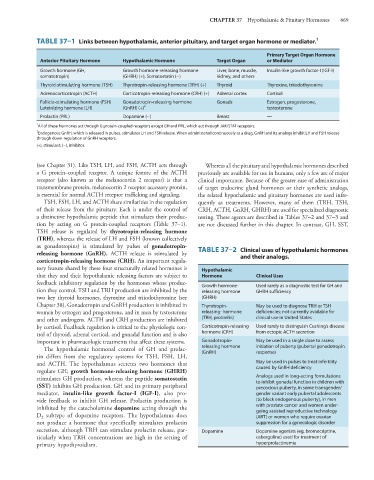Page 683 - Basic _ Clinical Pharmacology ( PDFDrive )
P. 683
CHAPTER 37 Hypothalamic & Pituitary Hormones 669
TABLE 37–1 Links between hypothalamic, anterior pituitary, and target organ hormone or mediator. 1
Primary Target Organ Hormone
Anterior Pituitary Hormone Hypothalamic Hormone Target Organ or Mediator
Growth hormone (GH, Growth hormone-releasing hormone Liver, bone, muscle, Insulin-like growth factor-I (IGF-I)
somatotropin) (GHRH) (+), Somatostatin (−) kidney, and others
Thyroid-stimulating hormone (TSH) Thyrotropin-releasing hormone (TRH) (+) Thyroid Thyroxine, triiodothyronine
Adrenocorticotropin (ACTH) Corticotropin-releasing hormone (CRH) (+) Adrenal cortex Cortisol
Follicle-stimulating hormone (FSH) Gonadotropin-releasing hormone Gonads Estrogen, progesterone,
Luteinizing hormone (LH) (GnRH) (+) 2 testosterone
Prolactin (PRL) Dopamine (−) Breast —
1
All of these hormones act through G protein-coupled receptors except GH and PRL, which act through JAK/STAT receptors.
2 Endogenous GnRH, which is released in pulses, stimulates LH and FSH release. When administered continuously as a drug, GnRH and its analogs inhibit LH and FSH release
through down-regulation of GnRH receptors.
(+), stimulant; (−), inhibitor.
(see Chapter 31). Like TSH, LH, and FSH, ACTH acts through Whereas all the pituitary and hypothalamic hormones described
a G protein–coupled receptor. A unique feature of the ACTH previously are available for use in humans, only a few are of major
receptor (also known as the melanocortin 2 receptor) is that a clinical importance. Because of the greater ease of administration
transmembrane protein, melanocortin 2 receptor accessory protein, of target endocrine gland hormones or their synthetic analogs,
is essential for normal ACTH receptor trafficking and signaling. the related hypothalamic and pituitary hormones are used infre-
TSH, FSH, LH, and ACTH share similarities in the regulation quently as treatments. However, many of them (TRH, TSH,
of their release from the pituitary. Each is under the control of CRH, ACTH, GnRH, GHRH) are used for specialized diagnostic
a distinctive hypothalamic peptide that stimulates their produc- testing. These agents are described in Tables 37–2 and 37–3 and
tion by acting on G protein-coupled receptors (Table 37–1). are not discussed further in this chapter. In contrast, GH, SST,
TSH release is regulated by thyrotropin-releasing hormone
(TRH), whereas the release of LH and FSH (known collectively
as gonadotropins) is stimulated by pulses of gonadotropin-
releasing hormone (GnRH). ACTH release is stimulated by TABLE 37–2 Clinical uses of hypothalamic hormones
and their analogs.
corticotropin-releasing hormone (CRH). An important regula-
tory feature shared by these four structurally related hormones is Hypothalamic
that they and their hypothalamic releasing factors are subject to Hormone Clinical Uses
feedback inhibitory regulation by the hormones whose produc- Growth hormone- Used rarely as a diagnostic test for GH and
tion they control. TSH and TRH production are inhibited by the releasing hormone GHRH sufficiency
two key thyroid hormones, thyroxine and triiodothyronine (see (GHRH)
Chapter 38). Gonadotropin and GnRH production is inhibited in Thyrotropin- May be used to diagnose TRH or TSH
women by estrogen and progesterone, and in men by testosterone releasing- hormone deficiencies; not currently available for
and other androgens. ACTH and CRH production are inhibited (TRH, protirelin) clinical use in United States
by cortisol. Feedback regulation is critical to the physiologic con- Corticotropin-releasing Used rarely to distinguish Cushing’s disease
trol of thyroid, adrenal cortical, and gonadal function and is also hormone (CRH) from ectopic ACTH secretion
important in pharmacologic treatments that affect these systems. Gonadotropin- May be used in a single dose to assess
The hypothalamic hormonal control of GH and prolac- releasing hormone initiation of puberty (pubertal gonadotropin
tin differs from the regulatory systems for TSH, FSH, LH, (GnRH) response)
and ACTH. The hypothalamus secretes two hormones that May be used in pulses to treat infertility
regulate GH; growth hormone-releasing hormone (GHRH) caused by GnRH deficiency
stimulates GH production, whereas the peptide somatostatin Analogs used in long-acting formulations
(SST) inhibits GH production. GH and its primary peripheral to inhibit gonadal function in children with
precocious puberty, in some transgender/
mediator, insulin-like growth factor-I (IGF-I), also pro- gender variant early pubertal adolescents
vide feedback to inhibit GH release. Prolactin production is (to block endogenous puberty), in men
inhibited by the catecholamine dopamine acting through the with prostate cancer and women under-
going assisted reproductive technology
subtype of dopamine receptors. The hypothalamus does
D 2 (ART) or women who require ovarian
not produce a hormone that specifically stimulates prolactin suppression for a gynecologic disorder
secretion, although TRH can stimulate prolactin release, par- Dopamine Dopamine agonists (eg, bromocriptine,
ticularly when TRH concentrations are high in the setting of cabergoline) used for treatment of
primary hypothyroidism. hyperprolactinemia

